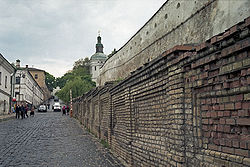
Pechersk Lavra fortification
Encyclopedia

Kiev Pechersk Lavra
Kiev Pechersk Lavra or Kyiv Pechersk Lavra , also known as the Kiev Monastery of the Caves, is a historic Orthodox Christian monastery which gave its name to one of the city districts where it is located in Kiev, the capital of Ukraine....
in Kiev
Kiev
Kiev or Kyiv is the capital and the largest city of Ukraine, located in the north central part of the country on the Dnieper River. The population as of the 2001 census was 2,611,300. However, higher numbers have been cited in the press....
, the capital of Ukraine
Ukraine
Ukraine is a country in Eastern Europe. It has an area of 603,628 km², making it the second largest contiguous country on the European continent, after Russia...
.
History
The fortification around the monastery first arouse at the end of the 12th century, when a 2 metre wide leave, 5 metre high stone wall was erected. This wall was destroyed during the Mongol invasion of RusMongol invasion of Rus
The Mongol invasion of Russia was resumed on 21 December 1237 marking the resumption of the Mongol invasion of Europe, during which the Mongols attacked the medieval powers of Poland, Kiev, Hungary, and miscellaneous tribes of less organized peoples...
and was finally excavated by archeologists in 1951. After the Mongol invasion, the monastery was defended by wooden walls. In 1679, Hetman
Hetmans of Ukrainian Cossacks
Hetman of Ukrainian Cossacks as a title was not officially recognized internationally until the creation of the Ukrainian Hetmanate. With the creation of Registered Cossacks units their leaders were unofficially referred to as hetmans, however officially the title was known as the "Senior of His...
Ivan Samoylovych
Ivan Samoylovych
Ivan Samoylovych was the Hetman of Left-bank Ukraine from 1672 to 1687. His term in office was marked by further incorporation of the Cossack Hetmanate into the nascent Russian Empire and by attempts to win the Right-bank Ukraine from Poland-Lithuania....
had a moat and new ramparts added to the fortification around the "upper monastery."
Hetman Ivan Mazepa
Ivan Mazepa
Ivan Stepanovych Mazepa , Cossack Hetman of the Hetmanate in Left-bank Ukraine, from 1687–1708. He was famous as a patron of the arts, and also played an important role in the Battle of Poltava where after learning of Peter I's intent to relieve him as acting Hetman of Ukraine and replace him...
financed the fortification's construction at the height of the Great Northern War
Great Northern War
The Great Northern War was a conflict in which a coalition led by the Tsardom of Russia successfully contested the supremacy of the Swedish Empire in northern Central Europe and Eastern Europe. The initial leaders of the anti-Swedish alliance were Peter I the Great of Russia, Frederick IV of...
, and had a thick stone wall with four towers added for protection of the monastery in case of Swedish
Sweden
Sweden , officially the Kingdom of Sweden , is a Nordic country on the Scandinavian Peninsula in Northern Europe. Sweden borders with Norway and Finland and is connected to Denmark by a bridge-tunnel across the Öresund....
or Russian attack.
In 1706, Tsar Peter I
Peter I of Russia
Peter the Great, Peter I or Pyotr Alexeyevich Romanov Dates indicated by the letters "O.S." are Old Style. All other dates in this article are New Style. ruled the Tsardom of Russia and later the Russian Empire from until his death, jointly ruling before 1696 with his half-brother, Ivan V...
ordered the construction of the so-called "Old Cave Fortress." The earliest plans for the fortress were done by engineer named Gellert. It was completed in 1723, and consisted of a semicircular citadel
Citadel
A citadel is a fortress for protecting a town, sometimes incorporating a castle. The term derives from the same Latin root as the word "city", civis, meaning citizen....
with a 6 metre high earthen rampart, eight bulwark
Bulwark
Bulwark may refer to:*A bastion or fortifications in general*In naval terminology, an extension of a ship's sides above deck level*HMS Bulwark, any of several Royal Navy ships*USS Bulwark, any of several US Navy ships...
s, and other fortifications.
During the 18th and 19th centuries, the fortress was rebuilt again. During that time, the Old Cave Fortress constructed in the 18th century was the base for the administrative and military institutions of the Russian Empire
Russian Empire
The Russian Empire was a state that existed from 1721 until the Russian Revolution of 1917. It was the successor to the Tsardom of Russia and the predecessor of the Soviet Union...
in the city.
Constructions

- the Southwest Tower, also called the tower of Ivan Kuschnik, taken from the name of the church that was supposed to be constructed in the tower but was not built;
- the South Tower, or the Horlogium, because it had an installed clock up to 1818;
- the North Tower, also called the Painting Tower, because it once held a paining studio;
- and the East Tower containing the church of Saint Onufry, also called the Chamber Tower because at one time it contained Hetman Mazepa's chambers.
Near the North Tower, there is a water tower
Water tower
A water tower or elevated water tower is a large elevated drinking water storage container constructed to hold a water supply at a height sufficient to pressurize a water distribution system....
, which is not part of the Lavra fortification system. It was designed by the architect V. Sychugov and constructed to ensure the Lavra's fresh water supply in 1879.

